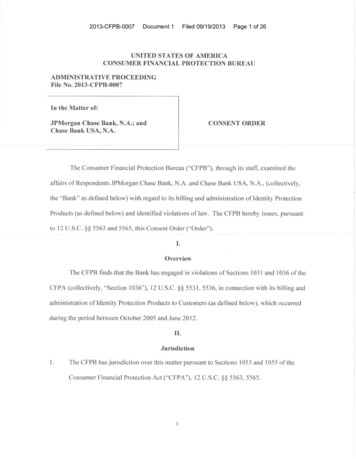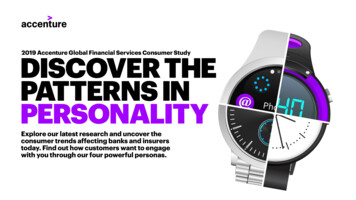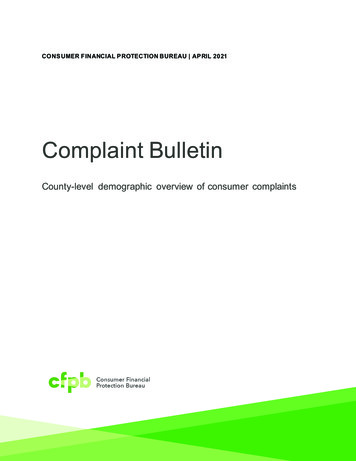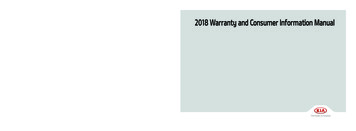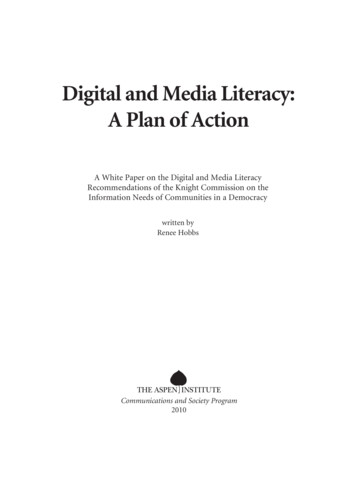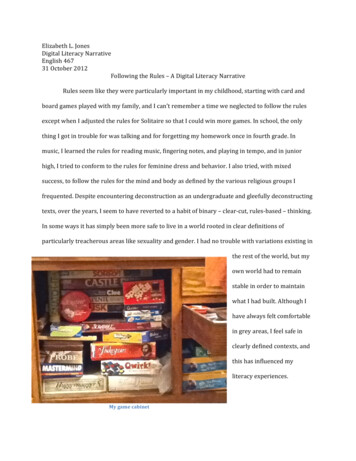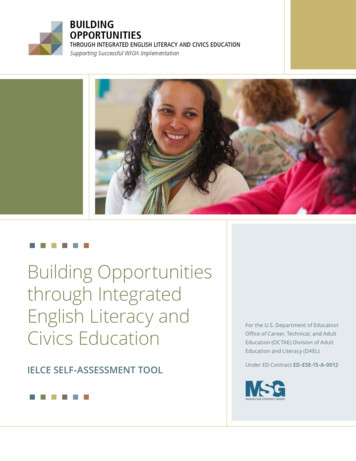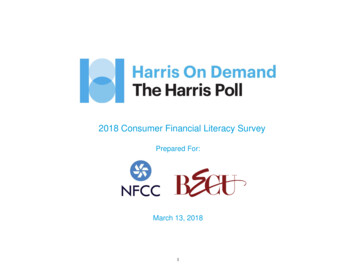
Transcription
2018 Consumer Financial Literacy SurveyPrepared For:March 13, 20181
Survey MethodologyThe 2018 Financial Literacy Survey was conducted online within the United States by Harris Poll on behalf of the NFCC (National Foundation for CreditCounseling) between February 28th and March 2nd, 2018 among 2,017 U.S. adults ages 18 . Figures for age, sex, race/ethnicity, education, region andhousehold income were weighted where necessary to bring them into line with their actual proportions in the population. Propensity score weighting was used toadjust for respondents’ propensity to be online. Prior to 2013, this survey was conducted by telephone.All sample surveys and polls, whether or not they use probability sampling, are subject to multiple sources of error which are most often not possible to quantify orestimate, including sampling error, coverage error, error associated with nonresponse, error associated with question wording and response options, and postsurvey weighting and adjustments. Therefore, Harris Poll avoids the words “margin of error” as they are misleading. All that can be calculated are different possiblesampling errors with different probabilities for pure, unweighted, random samples with 100% response rates. These are only theoretical because no published pollscome close to this ideal.Respondents for this survey were selected from among those who have agreed to participate in Harris Poll surveys. The data have been weighted to reflect thecomposition of the adult population. Because the sample is based on those who agreed to participate in the Harris Poll panel, no estimates of theoretical samplingerror can be calculated.Significance TestingWhen results from sub-groups of a sample appear in the detailed tabulations, an indicator of statistically significant differences is added to the tables run on ourstandard demographic banners. Significance testing is done to the 95% confidence level, and the test is performed on percentages as well as mean values. Eachsub-sample is assigned a letter. When the percentage of one sub-sample is significantly different from the percentage of another sub-sample, the letterrepresenting one of the two samples appears next to the percentage (or mean) of the other sample.For instance, the percentage of males answering yes to a particular question may be compared to the percentage of females answering yes to the same question.In the example below, the male sample is assigned the letter B, and the female sample is assigned the letter C. Here, respondents were asked whether a certainbusiness practice is acceptable. 67% of women said that it was -- a proportion significantly greater than the 57% of males who believe that the practice isacceptable. To indicate that women are significantly more likely to find the practice acceptable than are men, the letter B -- the letter assigned to the male subsample -- appears next to the “67%” in the female column. Similarly, the 37% of men that find the practice unacceptable is significantly greater than the 29% ofwomen who do so and, therefore, the letter C -- the letter assigned to the female sub-sample -- appears next to the “37%” in the male 03Acceptable61163%27457%33767%BNot Acceptable31933%17137%C14829%Don’t Know374%184%194%Unweighted BaseWeighted Base2
Key FindingsBudget, Spending, & SavingIn 2018, about two in five U.S. adults (41%) – a proportion that has held roughly steady since 2007 – say they have a budget and keep close track of how muchthey spend on such things as food, housing, and entertainment.About half of U.S. adults (51%) are now spending the same as last year, while about 1 in 4 each report they are now spending more (24%) or less (25%) thanbefore. The most influential factor when deciding how to pay in certain situations (i.e., cash vs. debit vs. credit) remains the amount of the purchase (49%),followed by the points/rewards they can earn by using their credit card (40%) and where/how they are shopping (online vs. brick-and-mortar store) (36%).Over half of adults (53%) say they are now saving the same as last year, while the proportion of those who say they are saving more has increased slightly tonearly 3 in 10 (29% vs. 26% in 2017).The proportion of U.S. adults that has non-retirement savings remains nearly 7 in 10 (69%), but where adults are saving or investing their money varies: as inprevious years, 2 in 3 continue to use a savings account (66%), but the use of 401k plans (37%) and investments/mutual funds (30%) has increased since 2017(32% and 26%, respectively).RetirementWhen it comes to retirement savings, nearly 2 in 3 U.S. adults (65%) say they save some portion of their household’s annual income for retirement, an increase of5 percentage points since last year (60%).Despite the fact that most are saving at least something for retirement, fewer than 1 in 5 U.S. adults (19%) feel very confident – and about 3 in 10 (29%) revealthey are not at all confident – that they are saving enough. And, when asked what areas of personal finance worry them most, the top response is still retiringwithout having enough money set aside (16%), followed closely by insufficient “rainy day” savings (14%).HomeownershipNearly 4 in 5 U.S. adults (78%) have tried to purchase their own home, and 72% are currently homeowners.The top 5 barriers faced by potential homeowners are: Rising home prices; Lack of funding for the down payment or closing costs; Existing debt; Limited housing options within available budget; and, Poor credit history or low credit score.Credit Card DebtA majority of U.S. adults (61%) have had credit card debt in the past 12 months, and nearly 2 in 5 (38%) indicate their household carries such debt from month tomonth. Few have done something in an attempt to obtain a lower interest rate for their credit card debt, primarily because they are satisfied with their current ratesor they had never thought of it.3
Key Findings (continued)Knowledge of, and Confidence in, Personal FinanceOver half of U.S. adults (55%) continue to give themselves a grade of A or B on their knowledge of personal finance, and 9 in 10 (90%) say they are very orsomewhat confident that the last time they made a big financial decision (such as picking a credit card, buying a car, or refinancing their mortgage), they madethe right choice. More than 3 in 4 (77%) feel knowledgeable about how their credit score is determined; About 4 in 5 (79%) feel knowledgeable about the fees their bank or financial institution charges; and, Just over half (52%) say they are knowledgeable about payday loans and other types of high-interest short-term loans (52%), an increase of 5 percentagepoints from 2017 (47%).Yet, about 8 in 10 (79%) agree – including nearly three in ten (29%) who strongly agree – that they could still benefit from advice and answers to everydayfinancial questions from a professional. In fact, when asked who they would turn to for general financial/money management guidance, the top response is afinancial professional such as a CPA or financial planner (37%), followed closely by friends and family (36%).In 2018, fewer U.S. adults would turn to a bank or credit union for financial advice (25% vs. 32%).Debt and Credit CounselingWhile nearly 3 in 4 U.S. adults (72%) continue to pay all their bills on time and have no debts in collection, one in four (25%) admit they do not pay their bills ontime and nearly 1 in 10 (8%) now have debts in collection, both a slight increase from last year (22% and 5%, respectively).Only 15% of all U.S. adults say they have never had any debt, while more than half (55%) struggle to minimize their debt, primarily due to unexpected financialemergencies (24%).When asked why they would not reach out to a professional non-profit credit counseling agency for help if they were having financial problems related to debt,about one in five adults (21%) say they can resolve their own problems without outside help, and a similar proportion (19%) don’t know which agency to turn to, aslight increase since last year (15%).About one in four U.S. adults (24%), or almost 59 million Americans1, indicated they would reach out to a professional non-profit credit counseling agency for help.Small Business FinancingIf they were looking to start a new business Nearly 1 in 3 (32%) would seek a business loan through a community (15%) or national (14%) bank, credit union (17%), or online-only lender (6%) About 1 in 4 (26%) would rely on personal funds (22%) or liquidate personal assets (9%) Nearly 1 in 5 would apply for a public or private grant (19%), or seek an SBA-backed loan (18%)One in three U.S. adults (34%) are not at all sure how they would come up with the money if they were looking to finance a new business.1Calculation based on U.S. Census Bureau’s 2016 Current Population Survey (CPS), which estimates there are 244.81 million adults ages 18 residing in the United States:244.81M x 0.24 58.75M.4
Posted Topline tal2014%Which of the following bestdescribes how you manage Total2009%Total2008%Total2007%Base: Adults 18 (n 2,017)(n 1,649)(n 1,668)(n 2,017)(n 2,016)(n 2,037)(n 1,007)(n 1,010)(n 2,028)(n 1,000)(n 1,001)(n 1,003)ABCDEFGHIJKLI have a budget and keep close trackof how much I spend on such thingsas food, housing and entertainment41404040394043 E43 E43 EL424239Don’t Have A Budget (Net)5960 GHI60 GHI60 GHI61 GHIJ60 GHI56565657N/AN/AI have a somewhat good ideaabout how much I spend on suchthings as food, housing andentertainment, but I don’t keepstrict track of my spending on L48GHIJKL34343739 GH3536I don’t have a good idea how muchI spend on such things as food,housing and entertainment, but Ikeep track of my overall spendingand try to stay within certain limitsthat I’ve set for myself89998815ABCDEFJK15ABCDEFJK14ABCDEFJ11 AEF12ABCDEF15ABCDEFJKI don’t have a good idea how muchI spend on such things as food,housing and entertainment, and Ioften don’t keep track of my DEFI7ABCDEFIDon’t /AN/A****215
Q710Total 2018%Total 2017%Total 2016%Total 2015%Total 2014%Which of the following bestdescribes your financialsituation?Total 2013%Total 2012%Total 2011%Total 2010%Total 2009%Total 2008%Base: Adults 18 (n 2,017)(n 1,649)(n 1,668)(n 2,017)(n 2,016)(n 2,037)(n 1,007)(n 1,010)(n 2,028)(n 1,000)(n 1,001)ABCDEFGHIJKI pay all of my bills on time andhave no debts in collection72 GHI75ADEFGHIJK74DEFGHIJK71 G71 G71 G646869 G70 G69 GDo Not Pay All Bills On Time(Net)25 BC2222242426 BC28 BCDE28ABCDE26 BCN/AI sometimes miss a paymentbut have no debts incollection101099101014ABCDEFJK13ABCDEFJ1011I struggle to pay my billsevery month but have nodebts in collection77777811ABCDEFH89 ABCDE10ABCDE97BCFGHIJK456 BGHIJ6 BGHIJ544445I am seriously consideringfiling for bankruptcy or havefiled for bankruptcy in thepast three years2 BCDE11112 BCDE3 BCDE2 BCDE2 BCDE2 BCDE2 BCDEI am not involved at all in anyfinancial decisions including howmoney is spent in our household3 GHIJ3 GHJ3 GHJ5ABCFGHIJK4 GHIJK3 GHIJ112 GHJ12Don’t /A*11118992ACDEFH90888990 D908991 ADE91 DN/A8 BCIJ567B7B7B7B7B66N/AI am getting calls fromcollectors and struggle to paymy bills every monthSpecial Net: No debts incollectionSpecial Net: Debts incollection633ABCDEFHIJ15ABCDEFJK
Q715Total 2018%Total 2017%The last time you made a big financial decision (e.g., picking a credit card,buying a car, refinancing your mortgage), how confident were you thatyou made the right choice?Total 2016%Total 2015%Base: Adults 18 (n 2,017)(n 1,649)(n 1668)(n 2,017)ABCD9092 A9192 AVery confident52555552Somewhat confident37383640 C10 BD898Not very confident7B566Not confident at all3D332Very/Somewhat Confident (Net)Not at all/Not Very Confident (Net)7
Q720Total 2018%Total 2017%Which of the following areas of personal finance currentlyworries you most?Total 2016%Total 2015%Total 2014%Base: Adults 18 (n 2,017)(n 1,649)(n 1,668)(n 2,017)(n 2,016)ABCDE73 D75 CDE7170713034 ACD292831 DRetiring without having enough money set aside1618 CD151516Not enough “rainy day” savings for an emergency1416 D141316 D1113121313Losing my job68 ACD667Not being able to find a good-paying job5568 ABCE688887Not being able to pay my credit card debt3D3324DNot being able to repay my student loan debt3E334E2Not being able to pay my existing medical debt11111Not being able to make my monthly vehicle payments1*1116 DE56 DE445 DE45 DE331112 ABCE1Not being able to afford health insurance44344Feeling as though my personal financial situation is out of control443434 BCDE2222That I may have to file for bankruptcy*1*1*Losing my home to foreclosure1112 ABCE12 BD12 BD12 BD33433None – I do not have any financial worries.232125 B24 B25 BNot sure4346 ABCE4Have Financial Worries (Net)Not Enough Savings (Sub-Net)Job-Related (Sub-Net)Not Being Able To Pay (Sub-Net)Credit Score/Access (Sub-Net)My credit scoreMy lack of access to creditNot being able to afford to send my child(ren) to collegeNot having a good, overall understanding of personal financeOther8
014%Do you have any savings,excluding retirement %Total2009%Total2008%(n 1,007)(n 1,010)(n 2,028)(n 1,000)(n 1,001)GHIJK5964 G67 GK65 G6333303236ABCFIBase: Adults 18 (n 2,017)(n 1,649)(n 1,668)(n 2,017)(n 2,016)A69DEGHJKBCDE68 GHK69 GHJK66 G66 G(n 2,037)F69DEGHJK39 ABCDEFHIJNo31323134 AFI34 AFI31Don’t /A222K21Q730Total 2018%Total 2017%Where do you save or invest your money? *Any Savings (Net)A savings account (e.g., regular bank savings, certificate ofdeposit, money market)401k planIRAsInvestments / mutual fundsAt home (e.g., under mattress, in a home safe)I have no savings or investmentsTotal 2016%Total 2015%Base: Adults 18 (n 2,017)A(n 1,649)B(n 1,668)C(n 2,017)D838383826665666537 BCD32 D32 D29262629 AD2530 B2632 B30 B1012 D12 D917171718* Multiple responses were allowed.9
Q733Total 2018%If you needed 2,000 for an emergency, where/ how would you get themoney? *Total 2017%Base: Adults 18 (n 2,017)(n 1,649)AB504820 B16An emergency fund (separate from a savings account)1514Sell something I own1513Take out a payday loan or other short-term loan99Borrow from a retirement account (e.g., IRA, 401k)77Sell or liquidate investments / mutual funds65Crowdfunding (e.g., GoFundMe, Kickstarter)34Other710 ANot at all sure1216 AA savings accountBorrow from friends and family* Multiple responses were allowed.10
Q735Total 2018%Total 2017%Total 2016%Total 2015%Total 2014%On average, whatpercentage of yourhousehold’s income doyou save every year forretirement?Total 2013%Total 2012%Total 2011%Total 2010%Total 2009%Total 2008%(n 2,028)(n 1,000)(n 1,001)Base: Adults 18 (n 2,017)(n 1,649)(n 1668)(n 2,017)(n 2,016)(n 2,037)(n 1,007)(n 1,010)ABCDEFGHIJK31 ABC36ABCDEFK32 ABC33ABCDK33ABCDK2828272629 C32ABCDK65BDEFGHIJ60 J62 DEJ5758595961 DJ5956N/A1% to 10%38 BDEIJK3436343537 DK353535343311% to 20%19DEFGJK19DEFGJK1716161616171716168 EFJ79 BEFIJ8 EFJ668 EF9 EFJ768 EFN/AN/AN/AN/AN/AN/AN/AN/AN/AN/A8712 A12 A13 AF11 A10 AN/AN/AN/AN/AN/ADon’t knowN/AN/AN/AN/AN/AN/A4458 GHI6 GHRefusedN/AN/AN/AN/AN/AN/A233220% or nothingAny (Net)More than 20%Already retiredDecline to answer11
Q740Total 2018%Total 2017%How confident are you that you are saving enough forretirement?Total 2016%Total 2015%Base: Adults 18 (n 2,017)(n 1,649)(n 1,668)(n 2,017)ABCD51505048Very confident1920 D1917Somewhat confident3230303149505052Not very confident20202222Not confident at all29302930Very/Somewhat Confident (Net)Not at all/Not Very Confident (Net)12
Total 2018%Q765Total 2017%Total 2016%Total 2015%Total 2014%Roughly how much creditcard debt, if any, does yourhousehold carry frommonth to month?Total 2013%Total 2012%Total 2011%Total 2010%Total 2009%(n 1,000)Base: Adults 18 (n 2,017)(n 1,649)(n 1,668)(n 2,017)(n 2,016)(n 2,037)(n 1,007)(n 1,010)(n 2,028)ABCDEFGHI38 DE39 CDE35333437 DE39 CDE23 E23 E21 E22 E1821 E25 CEF10 EF11 EF10 EF11 EF881046 AE55456 AE8 CDE76668 CDE16 DH16 DH14 D1115 DH 2,500 to 4,99935 AD43 5,000 to 9,9996 BCDH44 10,000 or more7 DGHI7 DGHI47 BAny (Net)Less than 2,500(Subnet) 1 to 499 500 to 999 1,000 to 2,499 2,500 or More (Subnet)NoneDecline to answer/RefusedDon’t know40 CDE28ABCDEF14ABCDEFGJ41 CDEF25 CDEFJ44ABCDEFG28ABCDEF13ACEFG11 EF6 AE57 ACDEFI9 CDE8 DE8 CDE10 BCDE16 DH14 D1216 DH16 DH445 AD45 AD5 AD35 DH5 DH5 DH35 DH5 DH6 GH56 GH7 DGHI4456 GH4348 B49 BF49 BF4553ABCDEFIJ50 BF48 B4615 GHIJ18 AGHIJ17 GHIJ18 AGHIJ18 AGHIJ18 AGHIJ46 GIJ44N/AN/AN/AN/AN/AN/A457 GH6G13
Q770Total 2018%Total 2017%Total 2016%Total 2015%In the last 12 months, have you ?*Total 2014%Total 2013%Total 2012%Total 2011%Total 2010%Total 2009%Base: Adults 18 (n 2,017)(n 1,649)(n 1,668)(n 2,017)(n 2,016)(n 2,037)(n 1,007)(n 1,010)(n 2,028)(n 1,000)ABCDEFGHIJ38 DEFH38 DEH35 DEH313135 DEH38 DEH3040CDEFH40CDEFH19DEGHIJ19DEGHIJ18 EGHIJ16 HIJ14 HJ17 EHIJ15 HIJ1012118 HIJ8 HIJ7 HI7 HI7 HI8 HIJ7 HI456H7 CEGH7 CEGH56E46E556E7 CEBeen late making a credit cardpayment8D77678D11ABCDEF9DMissed a credit card payment6 CDEF6 CDEF44348ACDEFH5E6 DEFGH6 BCDEFGH15ABCDEFH24 AE33 AE23 AE34 AE4 AE4 AE3 DEFGI3 EG3 EG2 EG12 EG12E2 EG2ENone of these62 J62 J65 GIJ69ABCFGIJ69ABCFGIJ65 AGIJ6169ABCFGIJ5958Don’t A*111Any (Net)Applied for a new credit cardBeen rejected for a new credit cardTransferred the balance from onecredit card to anotherMade a payment that was less thanthe minimum payment requiredCancelled a credit cardObtained a cash advance from mycredit card companyConsolidated my credit card debtinto a personal bill consolidationloan* Multiple responses were allowed.1412ABCDEFH8ABCDEFH15ABCDEFGH8ACDEFH
Total 2018%Total 2017%Total 2016%Total 2015%Total 2014Total 2013%%Base: Adults 18 Total 2012%Total 2011%Total 2010%Total 2009%(n 2,017)(n 1,649)(n 1,668)(n 2,017)(n 2,016)(n 2,037)(n 1,007)(n 1,010)(n 2,028)(n 1,000)ABCDEFGHIJ24 DEIJ22 IJ26 BDEIJ21 IJ21 IJ28ABDEIJ26 BDEIJ1818A lot more than last year8 DE78 DE6627ABDEIJ11ABCDEIJ10 BDEJ9 DE8 DE7A little more than last year16 IJ15 IJ17 IJ15 IJ15 IJ17 IJ18 BDEIJ17 IJ101051 FGHIJ53 FGHIJ51 FGHIJ52 FGHIJ50 FGHIJ40 GHIJ32 J31 J31 J242526 C2327 C29 ABC32ABCDE39ABCDEF42ABCDEFA little less than last year151615171718 AC19 AC23ABCDEFGA lot less than last year998912 ABCD14 ABCD21ABCDEF19ABCDEFDon’t A***1Q785Compared to one year ago, howhas the current economicclimate affected your spending?Are you now spending ?More (Net)The same as last yearLess (Net)1551ABCDEFGH57ABCDEFGHI2830ABCDEFGH ABCDEFGH2327ABCDEFH ABCDEFGHI
Q790Total 2018%Total 2017%Total 2016%Total 2015%Compared to one year ago, howhas the current economic climateaffected your saving habits?Total 2014%Total 2013%Total 2012%Total 2011%Total 2010%Total 2009%Base: Adults 18 (n 2,017)(n 1,649)(n 1,668)(n 2,017)(n 2,016)(n 2,037)(n 1,007)(n 1,010)(n 2,028)(n 1,000)ABCDEFGHIJ29BCDEGHIJ26 EGH26 EGH242329BCDEGHIJ212224238G7G8G7G7G9 BDEG578G9G21CDEGHIJ19 EGHJ18 HJ18 HJ1620 EGHIJ161417 H1553 FGHIJ54 FGHIJ58ABFGHIJ56 FGHIJ55 FGHIJ46 GHIJ384138391820 C1619 C22 ACD25ABCDEA little less than last year101091011 C11 CA lot less than last year810 AC79C10 DEF20ABCDEFIDon’t A0*1G2 GIAre you now saving ?More (Net)A lot more than last yearA little more than last yearThe same as last yearLess (Net)16
Q795Total 2018%Total 2017%Total 2016%Total 2015%On a scale from A
followed by the points/rewards they can earn by using their credit card (40%) and where/how they are shopping (online vs. brick-and-mortar store) (36%). Over half of adults (53%) say they are now saving the same as last year, while the proportion of those who say they are saving more has in


